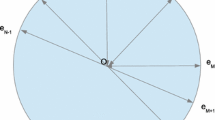Abstract
This paper uses submodularity to obtain monotonicity results for a class of Markovian queueing network service rate control problems. Nonlinear costs of queueing and service are allowed. In contrast to Weber and Stidham [14], our monotonicity theorem considers arbitrary directions in the state space (not just control directions), arrival routing problems, and certain uncontrolled service rates. We also show that, without service costs, transition-monotone controls can be described by simple control regions and switching functions. The theory is applied to queueing networks that arise in a manufacturing system that produces to a forecast of customer demand, and also to assembly and disassembly networks.
Similar content being viewed by others
References
F. Beutler and D. Teneketzis, Routing in queueing networks under imperfect information: stochastic dominance and thresholds, Stoch. and Stoch. Reports 26 (1989) 81–100.
J. Buzacott, S. Price and J.G. Shanthikumar, Service levels in multistage MRP and base stock controlled production systems, Working paper, U. of California, Berkeley (1991).
H. Chen, P. Yang and D. Yao, Control and scheduling in a two-station queueing network: optimal policies, heuristics, and conjectures, Math. Oper. Res. (1991), submitted.
H. Ghoneim and S. Stidham, Control of arrivals to two queues in series, Euro. J. Oper. Res. 21 (1985) 399–409.
P. Glasserman and D. Yao, Monotone optimal control of permutable GSMPs, Working paper, Columbia Univ., New York (1992).
B. Hajek, Optimal control of two interacting service stations, IEEE Trans. Auto. Control AC-29 (1984) 491–499.
B. Hajek, Extremal splittings of point processes, Math. Oper. Res. 10 (1985) 543–556.
J.M. Harrison,Brownian Motion and Stochastic Flow Systems (Wiley, New York, 1985).
S. Lippman, Applying a new device in the optimization of exponential queueing systems, Oper. Res. 23 (1975) 687–710.
Z. Rosberg, P. Varaiya and J. Walrand, Optimal control of service in tandem queues, IEEE Trans. Auto. Control AC-27 (1982) 600–610.
S. Stidham, Optimal control of admission to a queueing system, IEEE Trans. Auto. Control AC-30 (1985) 705–713.
S. Stidham, Scheduling, routing, and flow control in stochastic networks, in:Stochastic Control Theory and Applications, eds. W. Fleming and P.L. Lions, IMA vol. 10 (Springer, New York, 1988).
D. Topis, Minimizing a submodular function on a lattice, Oper. Res. 26 (1978) 305–321.
R. Weber and S. Stidham, Optimal control of service rates in networks of queues, Adv. Appl. Prob. 19 (1987) 202–218.
Author information
Authors and Affiliations
Rights and permissions
About this article
Cite this article
Veatch, M.H., Wein, L.M. Monotone control of queueing networks. Queueing Syst 12, 391–408 (1992). https://doi.org/10.1007/BF01158810
Received:
Revised:
Issue Date:
DOI: https://doi.org/10.1007/BF01158810




